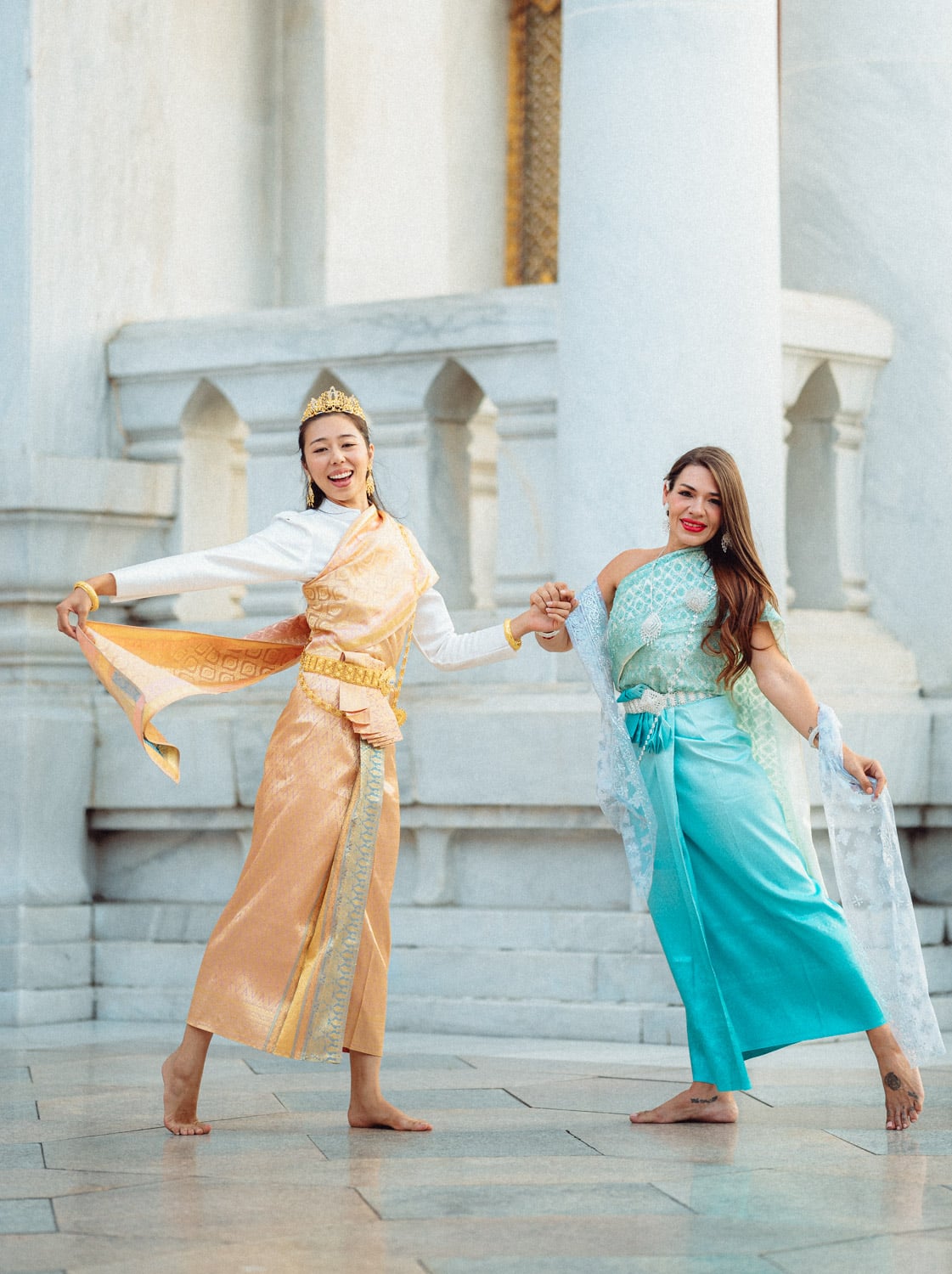The Living Heritage of Thai Dance
In the vibrant cultural tapestry of Thailand, few art forms capture the essence of Thai identity as completely as traditional dance. These mesmerizing performances represent more than entertainment; they are living museums where ancient stories, religious beliefs, and royal heritage converge in a spectacular display of grace and precision. The fluid hand gestures, the measured steps, and the deliberate postures all speak a silent language that has been refined over centuries. What makes Thai dance particularly special is its inseparable connection to costume—each movement is designed to work in harmony with the elaborate chut thai (Thai costume) worn by the performer. The shimmering headdresses catch light as dancers tilt their heads, while the structured shoulder pieces emphasize the subtle shoulder movements that characterize many Thai dance forms. For visitors to Bangkok seeking to immerse themselves in authentic Thai culture, witnessing these performances while wearing traditional attire offers a deeper connection to the kingdom’s artistic heritage.
The Evolution of Chut Thai Through the Dynasties
The development of Thai traditional costume mirrors the kingdom’s rich historical journey. From the early Sukhothai period through the Ayutthaya, Thonburi, and Rattanakosin eras, chut thai has evolved while maintaining core elements that make it instantly recognizable. During the Ayutthaya period (1350-1767), Thai costume reached new heights of sophistication, with royal wardrobes featuring intricate gold thread embroidery and jewel embellishments. The fall of Ayutthaya to Burmese forces in 1767 resulted in the loss of many original costume pieces, but the traditions were preserved through detailed chronicles and artistic depictions. The current Rattanakosin era has seen a revival of interest in historical costume accuracy, with researchers and designers consulting ancient temple murals and royal records to recreate authentic designs. Today’s thai costume rental services offer visitors and locals alike the opportunity to wear meticulously crafted replicas of these historical garments, connecting modern wearers to Thailand’s glorious past through fabric, form, and ornamentation.
The Sacred Geometry of Thai Dance Costumes
Look closely at a traditional Thai dance costume, and you’ll discover an intricate system of proportions and symbolic elements. Every component—from the towering chada headdress to the pointed finger extensions called jeeb—follows specific rules of sacred geometry that have been passed down through generations of master craftspeople. The costumes aren’t simply decorative; they’re functional tools that extend and amplify the dancer’s movements. The stiff collar piece called sabai enhances neck movements, while the pleated lower garment restricts leg motion to ensure proper posture. Gold and jewel tones dominate the color palette, representing divine light and celestial bodies. Red symbolizes power and vitality, while white represents purity and spiritual elevation. When dancers don these elaborate ensembles, they aren’t merely getting dressed—they’re transforming into living embodiments of celestial beings, ancient heroes, and mythological creatures from Thai literature. The weight and structure of authentic chut thai help dancers maintain the correct body alignment essential for performing the 108 standardized positions of classical Thai dance.
Regional Variations: The Diversity of Thai Dance Costumes
Thailand’s diverse geography has given rise to distinct regional dance styles, each with its own characteristic costume elements. Northern Thai dance costumes feature influences from the ancient Lanna kingdom, with softer silhouettes and textiles featuring natural motifs like flowers and animals. The dancers often wear fresh flowers in their hair and incorporate indigo-dyed cotton into their ensembles. In contrast, northeastern Isan dance costumes show influences from neighboring Laos and Cambodia, with vibrant silk patterns and ankle bells that accentuate the quick, energetic footwork typical of the region. Southern Thai dance costumes incorporate Islamic influences, with more modest coverage and intricate beadwork reflecting the coastal region’s historical trading connections. Central Thai dance costumes, particularly those associated with the royal court in Bangkok, tend to be the most elaborate and are what most international visitors recognize as “traditional Thai costume.” This rich tapestry of regional variations means that enthusiasts of Thai dance and costume have an endless world to explore, with each area offering its own unique aesthetic and historical significance.
The Modern Revival of Traditional Thai Costume
In recent years, Thailand has experienced a remarkable resurgence of interest in traditional costume. What was once reserved for formal ceremonies, performances, and national heritage events has found its way into contemporary fashion, wedding photography, and tourist experiences. Social media has played a significant role in this revival, with stunning photographs of people wearing chut thai at historical sites generating millions of views and inspiring both Thais and international visitors to experience traditional costume firsthand. Fashion designers are incorporating elements of traditional Thai textiles and silhouettes into modern collections, creating fusion pieces that honor heritage while remaining wearable in contemporary settings. This revival extends beyond mere aesthetics—it represents a deeper connection to cultural identity in an increasingly globalized world. For visitors to Thailand, renting an authentic Thai costume offers more than just a photo opportunity; it provides insight into the kingdom’s complex social history, artistic sensibilities, and spiritual worldview through direct, embodied experience.
The Nine Royal Thai Dance Costumes
Within the world of classical Thai performance, nine distinct royal dance costume styles hold special significance, each corresponding to specific characters and performance types. The Chut Thai Boromphiman, with its golden bodice and wing-like shoulder extensions, is reserved for characters representing celestial beings. The Chut Thai Chakri, featuring elaborate pleated lower garments and towering pointed headdresses, adorns dancers portraying royal characters from the Ramakien (Thai version of the Ramayana epic). The Chut Thai Dusit, with its more streamlined silhouette, is worn for portraying refined female characters like princesses and court ladies. Each costume type requires specific training to wear properly, as the weight distribution and structural elements influence movement in particular ways. Professional dancers spend years mastering not only the dance movements but also the proper handling and wearing of these elaborate ensembles. Visitors experiencing thai costume rental for photography or special events typically wear simplified versions that capture the aesthetic without requiring specialized movement training, though even these adaptations provide authentic connections to Thailand’s performance traditions.
The Craftsmanship Behind Thai Dance Costumes
The creation of a single traditional Thai dance costume represents hundreds—sometimes thousands—of hours of specialized craftsmanship. Master artisans train for decades to perfect their skills in gold thread embroidery, jewel setting, metal repousse work, and structured garment construction. A complete royal Thai dance costume involves multiple specialists: pattern cutters who understand the precise proportions needed for performance, embroiderers who execute intricate mythological motifs, metalworkers who create the sculptural elements, and dressers who know how to assemble the numerous components correctly. The most elaborate costumes used in royal-sponsored performances contain real gold thread and genuine gemstones, with some historic pieces valued as museum-quality treasures. While most thai costume rental services offer beautiful replicas using modern materials, these contemporary versions still require significant handcraftsmanship to accurately reproduce the visual impact of traditional designs. The knowledge behind this craftsmanship represents intangible cultural heritage that Thailand works diligently to preserve, with specialized schools training new generations in these ancient techniques to ensure their continuation.
Experiencing Thai Dance Through Costume
For those who truly wish to understand Thai dance, there is no substitute for experiencing the costume firsthand. The weight of a headdress alters one’s sense of balance and necessitates the characteristic slow, controlled movements. The restricted leg mobility imposed by traditional wrapped lower garments naturally produces the small, measured steps seen in classical performances. The raised shoulders created by structured costume elements transform ordinary posture into the distinctive silhouette associated with Thai dance. This embodied understanding is why many dance students begin learning basic movements while wearing practice versions of traditional costumes, gradually working up to the full ceremonial attire as their skills advance. Visitors to Bangkok can gain insight into this physical experience through thai costume rental services that provide authentic reproductions of performance attire, complete with guidance on proper wearing techniques and basic postures. This immersive approach creates deeper appreciation for the skill of professional dancers and the ingenuity of costume design that facilitates their mesmerizing performances.
The Spiritual Dimension of Thai Dance Costumes
Beyond their aesthetic and functional aspects, traditional Thai dance costumes hold profound spiritual significance. Before major performances, dancers participate in wai kru ceremonies to honor the spirits of dance masters past and present, with their costumes serving as vessels for temporary spiritual inhabitation. The mythological figures represented in dance often include deities and celestial beings, making the costume a sacred interface between the human and divine realms. Many traditional dance troupes maintain specific rituals for the handling, storage, and maintenance of costumes, acknowledging their role as more than mere garments. Headdresses in particular are treated with special reverence, often stored on elevated platforms and approached with a respectful wai (Thai greeting gesture). This spiritual dimension extends to how dancers mentally prepare for performances, with many describing the transformation that occurs when donning the complete costume as a form of meditative practice that connects them to an unbroken lineage of performers stretching back centuries. Even for casual wearers experiencing thai costume rental for photography or special events, understanding this spiritual context adds depth to the experience.
Preserving Heritage Through Accessibility
In Thailand’s rapidly modernizing society, institutions like museums, cultural centers, and specialized rental services play a crucial role in preserving dance costume traditions while making them accessible to wider audiences. The knowledge required to create, maintain, and properly wear traditional Thai costumes represents centuries of accumulated wisdom that could easily be lost without active conservation efforts. By offering experiences like thai costume rental to both domestic and international visitors, cultural enterprises create sustainable economic models that support master craftspeople and educators specializing in traditional arts. These services transform what might otherwise remain behind museum glass into living, participatory cultural encounters. When visitors don chut thai, take photographs, and share their experiences, they become unwitting ambassadors for Thai cultural heritage in the global digital sphere. This accessibility doesn’t diminish the significance of these traditions—rather, it ensures their continued relevance in contemporary society while generating appreciation for their complexity and beauty among new audiences who might otherwise never encounter them.
Experience the Magic of Thai Costume Yourself
Ready to immerse yourself in the splendor of traditional Thai culture? Visit SiamCrown at 236 Soi Luean Rit, Chakkrawat, Samphanthawong, Bangkok for an authentic chut thai experience. Our collection features meticulously crafted traditional costumes suitable for photography, special events, or simply connecting with Thailand’s rich cultural heritage. Open daily from 8:00 AM to 4:30 PM (returns by 6:00 PM), our English-speaking staff will guide you through selecting the perfect Thai costume rental for your needs. Browse our online gallery at siamcrown.com to preview our extensive collection, or contact us to reserve your preferred style in advance. Don’t just witness Thai culture—become part of its living tradition through the transformative experience of wearing authentic chut thai!



